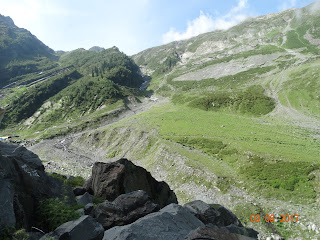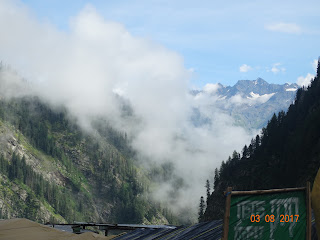Mountains, Hiker, Travel ,Lord Shiv, Manimahesh, Lakes, Mountain lakes
Manimahesh is a holy place of Hindu community & an high altitude lake located at an elevation of 4,080 m.asl situated close to the Manimahesh Kailash Peak in the Pir Panjal Range of the Himalayas, of the Bharmour region of Chamba district of Himachal Pradesh state in India. The religious importance of Manimahesh Lake is next to the Lake Manasarovar located in Tibet. The trek of Manimahesh is one of the beautiful treks of Himachal Pradesh. The lake is also known as Chamba Kailash & is believed to be the home of Lord Shiva (the Hindu deity). The lake is the venue of a highly revered pilgrimage trek undertaken during the month of August/September corresponding to the month of Bhadon according to Hindu calendar, on the eighth day of the New Moon period. It is known as the ‘Manimahesh Yatra’. The Government of Himachal Pradesh has declared it as a state-level pilgrimage.
Manimahesh Lake Manimahesh Kailash Peak
Manimahesh means “The bearer of Jewel” (Mani=Jewel; Mahesh=Lord Shiva). According to some local legend, the rays of moon reflects from the jewel can be grasped from Manimahesh Lake during the full moon night, which is called a rare occasion. However, a scientific article concludes that this type of phenomenon might be the result of light reflection from the glacier that aggrandizes the mountain peak in the form of a serpent around the neck of lord Shiva. Manimahesh Kailash has not been successfully summited by mountaineers till now and is thus called as virgin peak. An attempt as made to climb the peak in 1968 by an Indo–Japanese team led by Nandini Patel was terminated at that time. This failure is endorsed to the divine dexterity of the peak since it is admired as the holy mountain of Chamba according to the loyal devotees of the Manimahesh Lake.
The Manimahesh Lake is located at the base of Kailash peak (18,547 ft.) and both the places are well admired by the people of Himachal Pradesh. It is believed that these places are blessed by the Goddess Kali and protected by Lord Shiva. Thousands of devotees visit here to take a dip in the sacred water of Manimahesh Lake till the last day of the yatra, which is on the fifteenth day, following the Janamashtami festival during which a huge fair is held every year at this pious lake in the month of August/September. As per the folktale of the region, it is believed that Manimahesh Kailash is created by Lord Shiva after tying the knot with Goddess “Parvati”, who is worshiped as Mata Girja. There are copious folklore linking Lord Shiva and his show of displeasure through acts of avalanches and blizzards that occur in the region. As per the local myth, there is a rock formation in the form of a Shiv-ling on this mountain, which is the indicator as the appearance of Lord Shiva at this pious place. The snow field at the base of the mountain is recognized by the local people as Shiva's Chaugan.
Moreover, it is believed that Manimahesh Kailash is invincible, as till now no one has climbed it. It is believed and rumored that over the decades, a local tribe of nearby region had tried to climb the mountain along with their herd of sheep, but failed and turned into a stone along with his all herd. Another legend says that a serpent (snake) also tried to climb the mountain but failed and turned into stone. Pilgrims believe that if the Lord wishes then only, they can sight the peak. The peak is always covered with clouds & is also cited as the displeasure of the Lord shiv.
The climbing the Manimahesh peak has been resulted so far into failed attempts. It has been assessed that the hike and the fall of the peak could only be accomplished within 3 days having a cross of the N ridge and E wing into the Nainoni Valley and down to Kugti village. The conditions of the rocks are also wretched at higher elevations of the mountains.


Legend also remarks that Lord Shiva performed atonement on the periphery of Manimahesh Lake. In the same way, it is cited that Gaddis (Shepherd), the tribes of this region, adopted Lord Shiva as their deity since that times. These are the people who resided in the Gaddi Valley (upper regions of Ravi River where the Mount Chamba Kailash lies). Further, according to legend, the lord Shiva, presented the Gaddis with a Chuhali topi (pointed cap), which they wear it traditionally along with their other dress of Chola (coat) and Dora, a long black cord of about 10–15 m long. Since then Gaddis began to call the mountainous region as 'Shiv Bhoomi' (Land of Shiva) and themselves as devotees of Lord Shiva. The legends further states that lord Shiva & Parvati are the "parents of the universe" where Lord Shiva created the “Mount Kailash” in Himachal Pradesh and since then made it his abode, and Gaddis his devotees. The land where Gaddis lived then stretched about 24 km to west of Bharmour, upstream upto the confluence of rivers Ravi and Budhil, & Manimahesh. It was also stated that Manimahesh Mountain, is considered to the abode of other two Lords of the universe viz., Brahmaa & Vishnoo. It was referred as the heaven (Kaliasaa) of Lord Shiva.
The waterfall seen while hiking towards the lake at Dhancho originate from the Manimahesh Lake & was considered as the Vaikunta (heaven) of Lord Vishnu whereas the heaven of lord Brahmaa is quoted as a hillock overlooking the city of Bharmour. The Gaddis of the region known as the devotees of Lord Shiva, they believes that the their deity resides the Mount Kailash for about six months, thereafter he travels to the netherworld, handing over everything to Lord Vishnu & the day when lord Shiva proceeds to the netherworld is observed as reverentially every year by the Gaddis, which is also the day Janamashtami; the eighth day of the Bhadon (August) a month of Hindu calendar and the birth day of Lord Krishna (avatar of Lord Vishnu).
While it was believed that lord Shiva arrive to Bharmour from the netherworld at the end of February, before the day of his wedding night, the same day is observed as the Shiv-ratrii (The Night of Shiva); The day is believed to be spiritual, if anybody with pure heart mediate to lord Shiva on this day, whatever the wish is lord grants it. The devotees of lord Shiva observe the day as a festive day, since universal parents (Shiva and Parvati) has returned to Gaddi land at Mount Kailash.


There was a legend according to which Lord Shiva himself got tricked once. This chronicle was linked to Dhancho where devotees spent their night on their way to Manimahesh Lake. According to which Lord Shiva got pleased with the devotion of his ardent devotee known as Bhasmasur (Demon or Asura) & bestowed him a boon, which gave him the power of turning anyone into ashes if he put his hand over anyone’s head. After getting the boon he tortured everyone (from humans to gods) and then he desired to try the boon on lord Shiva himself. He, therefore, followed Lord Shiva to use the boon over him. Though, lord Shiva escaped from him and entered into a cave behind waterfall at Dhancho. Where, Bhasmasur was not able to enter because of some reason. At that time, Lord Vishnu interfered and killed the Bhasmasur. Since then, the same waterfall is considered as holy.
This chronicle is very popular, I have watched it in TV shows and listened from my elders too during my childhood, as it still amazes me.
Devotees recall an event rare, when the first ray of sun falls on the Mani Mahesh mountain peak, which can be seen in reflection inside the lake (like saffron tilak). This event in the lake has heightened the mythological belief of the tribal Gaddis on the sacredness of Manimahesh Lake of the Mount Kailash, which people now visit as a pilgrimage. This very event is believed to trigger the practice of taking bath in the lake during Janamashtami or Radhashtami day, which is on the fifteen day after the birth of Lord Krishna.
Geographically the lake is of glacial origin & is in the upper ranges of Ghoi Nala which is the tributary of Budhil & a Ravi River in Himachal Pradesh. However, the lake is the source of a tributary (of Budhil River), known as ‘Manimahesh Ganga’. Towards the end of June when ice start melting & various small streams disrupt from everywhere, which unruffled along the lavish green hills & the innumerable flowers provide the place mesmerizing view. To reach the Manimahesh lake there are three routes for devotees. Devotees from the Lahaul and Spiti regions come via Kugti pass, From Kangra & Mandi region they pass through Karwarsi or Jalsu pass through Tyari village, near Holi in Bharmour. Where, the most visited & popular route is from the Chamba via Bharmour. It is the route from Bharmour–Hadsar-Manimahesh route involving a 14 km track from Hadsar to the sacred Manimahesh Lake. The altitude that can be hiked in this route is 4115 m.asl and to reach there, it takes two days & a night stay at Dhancho.
On reaching the half way on way tented accommodations are available here during the yatra period (August–September) upto scared lake. Most of the devotees stay for a night at half a distance of the track which is 6 km of flat pasture land towards Dhancho. Free langars (free food) organized by people to feed pilgrims are available throughout the yatra. But a lot of people prefer to field their own tents near the sacred lake.
As discussed above, there is waterfall known as the Dhancho fall. From there, it is a steep climb towards the lake. The track is tough but is well maintained. It is said in the past that the first climb was done by crossing Dhancho nallah & it was very tough during that time that people were used to crawl to get pass. Since then people used to call it 'Bandar Ghati' (monkey valley) as they were used to crawl like a monkey to cross the stretch. However, some adventures devotees still prefer to take that old route & pass through the Bandar Ghati to reach the Lake.
Before, a bridge on the Mani Mahesh River was crossed to reach the left bank of the valley on a trek from Dhancho. Thereafter walking about 2 km, the same river was needed to be crossed again, over another bridge made of wood, to the right bank. From there, the trek has many zigzag turns through the paths along with meadows having beautiful flowers. Birch trees can be sighted in the vicinity indicating an increase in altitude as the trek continues. As I said earlier, along the whole route, there are number community based langars (eateries) available of about an altitude of 3,600 m.asl; from here the sacred “Mani Mahesh Lake” could be distinguished. The waterfall flowing from the lake can be sighted from here. An additional trek of about 1.5 km by crossing the bridge over the river, on one path through the grassy ridges leads to the sacred “Manimahesh Lake”.
Before & after this yatra period, the place remains isolated without inhabitants because the air at this place is fresh but ice-cold where most of the times, it remain under snow. There is a small lake near the base of Manimahesh peak called as “Gauri Kund”, the bathing place of goddess Parvati (Shiva's consort). Near the boundary of lake is a marbled appearance (called the Chaumukha) of Lord Shiva, which is now worshiped by visitors. The lake & its surroundings are so beautiful that the eyes of devotees can’t stop gazing the beauty of the divinity. The clear, still & untainted water of the lake reveal the snow-capped mounts that superintend the valley. There is also small incarnation of a temple in the shikhara style on the periphery where a brass image of Lakshmi Devi known as Mahishasuramardini is also idolized in the temple.

Jatra or Yatra also called as “Manimahesh Yatra”. It starts by a demonstration, locally known as "Chhari" (a holy trident stick carried by the devotees on their shoulders). Some of the pilgrims start the holy visit on their barefoot and travel a distance of about 14 km trek from the nearest road point (Hadsar) to the Manimahesh Lake. Lord Shiva is the only reigning deity of the yatra. The huge procession of the "Chhari" is escorted by singing and performance of hymns in admiration of Lord Shiva. Ponies are also available to hire by some devotees for the compilation of trek.
The holy trek of the yatra begins from the Laxmi Narayan temple & Dashnami Akhara of Chamba town, with 'Chhari' (the sacred stick) of Gur Charpathnath, which is carried by the pilgrims with active participation of sadhus. The trek from the Chamba to the sacred lake takes about 6 days. After the arrival of yatra at the lake, rituals are carried out through all night. On the next day, pilgrims take a holy dip (naun) in the lake. After which devotees takes a walk around the lake for three times as an act of devotion & seeking blessings of the Lord Shiva. However, female devotees’ takes dip in the Gauri Kund, which is found round a mile short of the Manimahesh Lake while men at Shiv Karotri (a part of Manimahesh lake). The priest of Brahmin family of Bharmour executes the Puja (Worship rituals) at Manimahesh Lake since the ancient times.
I have traveled with my friends from Jammu via Pathankot, Punjab to Chamba, Himachal Pradesh, then to Bharmour to Manimahesh Lake via Hadsar (Beginning point of the trek) to Dhancho. It took us five days to complete the trip and we came back to Chamba on the night fifth day while on the following day we were back to Jammu. It was really a tough trek for me but was very enjoyable.
https://en.wikipedia.org/wiki/Manimahesh_Lake
https://web.archive.org/web/20100628184333/http:/himachal.nic.in/tour/releg.htm
https://web.archive.org/web/20090410063443/http://cpreecenvis.nic.in/scared_waterbodies_manimahesh.htm
https://web.archive.org/web/20020827235344/http:/hpchamba.nic.in/Fairs%26festivals.htm
https://en.wikipedia.org/wiki/Manimahesh_Kailash_Peak#cite_ref-library_7-0
https://en.wikipedia.org/wiki/Manimahesh_Kailash_Peak#cite_ref-yatra_9-0





















Seems pretty cool
ReplyDeleteBeautiful Place
ReplyDelete